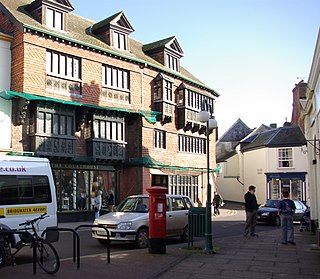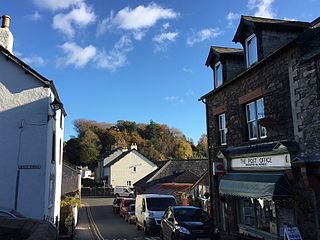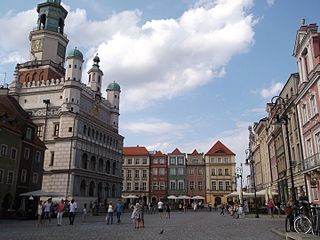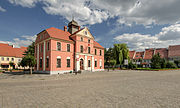
Herford is a town in North Rhine-Westphalia, Germany, located in the lowlands between the hill chains of the Wiehen Hills and the Teutoburg Forest. It is the capital of the district of Herford.

Hexham is a market town and civil parish in Northumberland, England, south of the River Tyne, and was the administrative centre for the Tynedale district from 1974 to 2009. In 2011, it had a population of 11,829.

St. Lawrence is a neighbourhood located in downtown Toronto, Ontario, Canada. The area, a former industrial area, is bounded by Yonge, Front, and Parliament Streets, and the Canadian National railway embankment. The Esplanade off Yonge St., lined with restaurants, cafés and hotels runs through the middle of the area. In previous times, the area was sometimes referred to as 'St. Lawrence Ward' or more often today as 'St. Lawrence Market', synonymous with the large retail vendor market which is the neighbourhood's focal point. The area is the site of a large city-sponsored housing project of the 1970s, which revitalized an old 'brownfields' area. The boundaries of the St Lawrence Neighbourhood Association and the St Lawrence Market BIA are somewhat larger than those noted above. Both groups have boundaries that extend from Yonge to Parliament Streets and Queen Street East to the rail corridor.

Wiveliscombe is a small town and civil parish in Somerset, England, situated 9 miles (14 km) west of Taunton in the Taunton Deane district. The town has a population of 2,893. The Square, fronted by several listed structures, held the former market. The parish includes the nearby hamlet of Maundown.

Broughton in Furness is a small market town on the south western boundary of England's Lake District National Park. It is located in the Furness region of Cumbria, which was originally part of Lancashire before 1974.
Buildings and structures in Sheffield have been constructed over a time-span ranging from the 13th century to the present day. The majority of Sheffield's older buildings were built during the Industrial Revolution, with a large number of medieval buildings demolished in the 19th century; some older buildings were lost during the Sheffield Blitz. Sheffield can only lay claim to five Grade I listed buildings, two of which are in the city centre.

Brzeg County is a unit of territorial administration and local government (powiat) in Opole Voivodeship, south-western Poland. It came into being on January 1, 1999, as a result of the Polish local government reforms passed in 1998. Its administrative seat and largest town is Brzeg, which lies 39 kilometres (24 mi) north-west of the regional capital Opole. The county also contains the towns of Grodków, lying 22 km (14 mi) south of Brzeg, and Lewin Brzeski, 17 km (11 mi) south-east of Brzeg.

The Old Market Hall is an Elizabethan building situated in the town centre of Shrewsbury, the county town of Shropshire, England.
Gmina Skarbimierz is a rural gmina in Brzeg County, Opole Voivodeship, in south-western Poland. Its seat is Skarbimierz Osiedle, near to the village of Skarbimierz, which lies approximately 4 kilometres (2 mi) south-west of Brzeg and 41 km (25 mi) north-west of the regional capital Opole.
Gmina Olszanka is a rural gmina in Brzeg County, Opole Voivodeship, in south-western Poland. Its seat is the village of Olszanka, which lies approximately 10 kilometres (6 mi) south of Brzeg and 35 km (22 mi) west of the regional capital Opole.
Gmina Niemodlin is an urban-rural gmina in Opole County, Opole Voivodeship, in south-western Poland. Its seat is the town of Niemodlin, which lies approximately 24 kilometres (15 mi) west of the regional capital Opole.

Kaartinkaupunki is a neighbourhood in the southern part of Helsinki, Finland.

Leśniczówka is a settlement in the administrative district of Gmina Lewin Brzeski, within Brzeg County, Opole Voivodeship, in south-western Poland. It lies approximately 4 kilometres (2 mi) north-west of Lewin Brzeski, 13 km (8 mi) south-east of Brzeg, and 27 km (17 mi) north-west of the regional capital Opole.

Łosiów is a village in the administrative district of Gmina Lewin Brzeski, within Brzeg County, Opole Voivodeship, in south-western Poland. It lies approximately 6 kilometres (4 mi) north-west of Lewin Brzeski, 11 km (7 mi) south-east of Brzeg, and 29 km (18 mi) north-west of the regional capital Opole.

Poznań Old Town is the centermost neighbourhood of the city of Poznań in western Poland, covering the area of the once walled medieval city of Poznań. It is called Stare Miasto in Polish, although that name may also refer to the wider administrative district of Stare Miasto, which extends to most of the city centre and northern parts of the city.

St. Lawrence Market is a major public market in Toronto, Ontario, Canada. It is located at Front St. East and Jarvis St in the Old Town district of Toronto. Until 2015 there were two buildings in the complex, with different purposes. Until it was demolished to make way for redevelopment, St. Lawrence Market North, on the north side of Front St, hosted weekly farmer's markets and antique markets. A public market had been held on the north building site since 1803. Several buildings housed the market, the most recent built in 1968. Starting in 2015, the North building has shut to allow for redevelopment. While the North site is redeveloped, its market functions have moved to south of the South building in a temporary building.

Flag of Lewin Brzeski - a town flag of the town of Lewin Brzeski, Opole Voivodeship in Poland. The flag of Lewin Brzeski is arranged in a tri-colour of: yellow, blue and green; with a shield, presenting the Coat of Arms of Lewin Brzeski in the top-left corner of the flag.

Market House in Newtownards, County Down, Northern Ireland, is a historic building. It was built between 1767 and 1771 by Robert Stewart, 1st Marquess of Londonderry to be the center of the market town, in lieu of the Newtownards Priory. It has served as a prison and as a town hall. It is currently the Ards Arts Centre and is also the home of the Ards Historical Society.




















